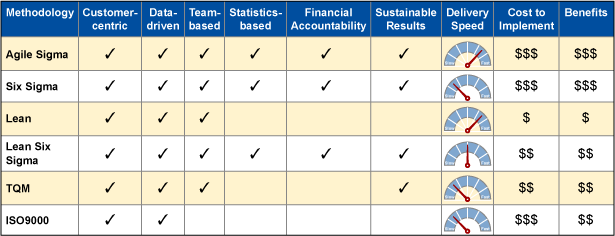
When it comes to selecting the “right” business process improvement methodology, many CEOs, CIOs and COOs have a wide array of options available including Six Sigma, Lean, Lean Six Sigma and ISO9000. The selection process then typically focuses on evaluating business drivers and deciding on an improvement methodology that closely matches their needs to improve business process performance and meet changing customer needs.
That’s where the challenge typically occurs for many executives – to find the methodology that consistently delivers significant impacts for customers and business operations while also doing so nimbly, innovatively and with agility. In other words, business executives today need a business process improvement methodology that enables significant, sustainable and customer-centric process improvement results – quickly and cost effectively.
Business executives feel the need for speed to remain competitive.
Existing Process Improvement Methodologies
To find the right methodology, the evaluation of available options typically includes the widely used approaches listed in Table 1, including pure and hybrid methods that have evolved over time. Specific attributes for each methodology are also listed, for comparison of the various approaches.
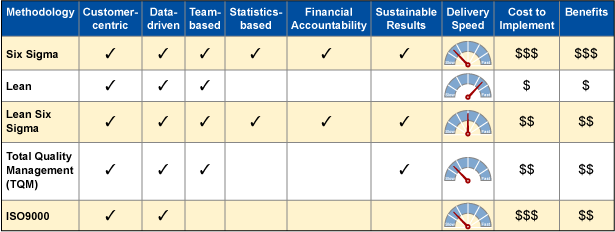
While Six Sigma programs have consistently delivered significant, sustainable and financially accountable results, the methodology is known as being “too slow” and “too stodgy” as well as relatively expensive to implement and grow. Further, Six Sigma improvement projects are typically designed to be one and done – to deliver a singular improvement in the process performance (sigma) level. Six Sigma projects then use controls to maintain and sustain that gain for at least a year, which by definition leaves process optimization opportunities on the table.
In contrast to Six Sigma, Lean principles and techniques have been employed in a variety of business process improvement programs, predominantly in manufacturing to deliver rapid improvements with little investment. Criticisms of lack of sustainability and financial accountability have been leveled at the Lean approach.
Lean Six Sigma is a hybrid approach that evolved as an option to utilize the synergies between the pure Six Sigma approach of reducing process variation and defects with the Lean principles of improving flow and eliminating wastes to improve process performance.
Developing Agile Sigma
The synergies between these two approaches – Agile and Six Sigma – to deliver more value together are apparent. Six Sigma provides significant and sustainable results, but takes too long (typically). On the other hand, Agile is fast and effective, using an iterative Scrum-based improvement approach leveraging team and tribal knowledge to meet users’ needs.
To benefit from that synergy, the best of Six Sigma and Agile have been combined into a single methodology – Agile Sigma. Development of the new methodology began in 2016, and Agile Sigma is now ready to be used by any type of business to improve their processes significantly and quickly to deliver increased value for their customers.
Agile Sigma can enable businesses to deliver improved processes more quickly and effectively.
The new Agile Sigma approach is a four-phase adaptation of the standard five phase Six Sigma DMAIC (Define, Measure, Analyze, Improve, Control) methodology – to provide a streamlined process for more efficient execution and results.
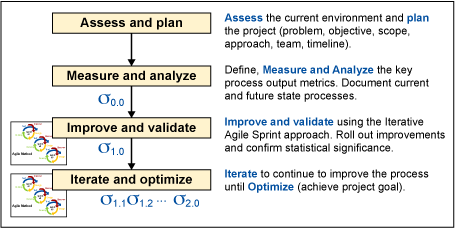
The four phases of Agile Sigma as shown in Figure 1 are:
- Phase 1.0: Assess and plan
- Phase 2.0: Measure and analyze
- Phase 3.0: Improve and validate
- Phase 4.0: Iterate and optimize
Agile Sigma also preserves and includes the most effective attributes of the Six Sigma DMAIC approach, including customer-centric process and metrics analysis, statistical analysis-based decision-making, financial accountability and sustainability of results.
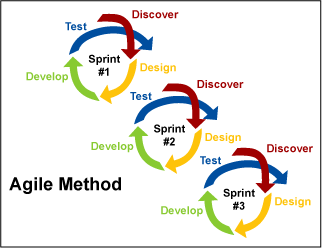
The Agile Sigma method also integrates the Scrum team approach, sprint cycles and iterative process improvement techniques of the standard Agile development method (as shown in Figure 2) to deliver significantly improved processes more rapidly. Agile Sigma uniquely applies the iterative sprint cycle concepts to the Six Sigma project approach, to initially achieve and validate an improved process Sigma level as the first level of improvement (i.e., moving from a baseline of σ0.0 [baseline] to σ1.0 [new improved process performance level]) before transitioning to the Control phase.
After the initial improvement, when most Six Sigma projects would be going for closure, the Agile Sigma team then continues to improve and validate the process iteratively via additional sprints to deliver optimized process performance before closing the project and sustaining the results and financial benefits for 12 months.
The Key Differences
Streamlined Process to Deliver Projects Effectively and Quickly
Agile Sigma streamlines the standard DMAIC approach for process improvement by combining, replacing and refining activities, while also identifying activities that could be accomplished concurrently. In Agile Sigma, iterative team-centric processes are used to improve and validate processes prior to statistical testing. In contrast, on Six Sigma DMAIC projects, large amounts of time and effort are expended by the team to identify, prioritize, collect, analyze and package possible process inputs that may affect the outputs significantly.
Iterative Processes that Leverage Team Expertise and Knowledge for a Quicker Path to Improvements
Agile Sigma uses iterative processes for multiple sprint cycles to deliver improved process performance. Within each sprint cycle, there are iterative Scrum-validation team cycles to enable identifying and using key contributing factors to improve, and then test and validate the improvements. The Scrum and validation teams use their expertise and knowledge via this iterative cycle to improve the process to meet the sprint objectives prior to statistical testing and analysis.
In Agile Sigma, through use of this iterative Scrum-validation team cycle, nested within an iterative sprint cycle, the teams hone in on and “tune” the improvements that make a difference to the users and customers of the process prior to statistical testing and rollout when significance is demonstrated.
Optimizes Processes – Iterate Until Optimized, No One-and-Done Improvements
Once the improvements have been rolled out in a Six Sigma project, the results are maintained and sustained for 12 months to achieve the financial benefits projected based on the initial improvements. One and done. No further improvements are typically implemented once in the Control phase.
In contrast, on an Agile Sigma project, once the initial improvements have been rolled out, then the Scrum and validation teams continue to iterate and optimize the process (in the final project phase) to achieve ever-higher process sigma performance levels (e.g., σ1.1, σ1.2, σ2.0, etc.), iteratively and incrementally to achieve project goals (see Figure 3 below).
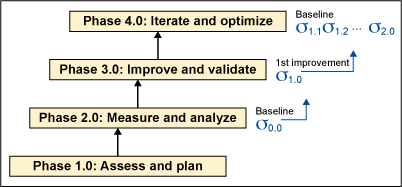
Existing Process Improvement Methodologies, Including Agile Sigma
With the introduction of Agile Sigma as an option available to business executives, there is now an alternative that provides all the benefits of Six Sigma, while retaining the rapid delivery of benefits attributes of Agile. Agile Sigma offers business executives and managers an option that:
- Delivers results quickly: Improves processes iteratively, satisfying the need for speed
- Enables data-driven decision-making based on statistics: You’re making “good” decisions
- Delights your customers: The methodology, metrics and tools are all customer-centric
- Provides financial accountability: You’re getting the actual benefits on the books
- Uses the existing team’s knowledge and expertise: To deliver improvements that matter more quickly
